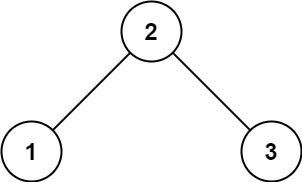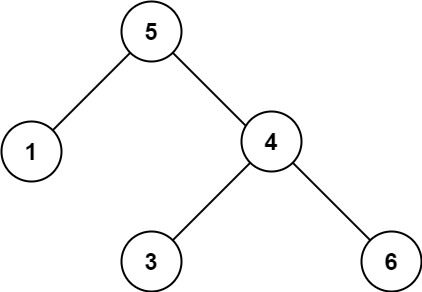| comments | difficulty | edit_url | tags | ||||
|---|---|---|---|---|---|---|---|
true |
中等 |
|
给你一个二叉树的根节点 root ,判断其是否是一个有效的二叉搜索树。
有效 二叉搜索树定义如下:
- 节点的左子树只包含 小于 当前节点的数。
- 节点的右子树只包含 大于 当前节点的数。
- 所有左子树和右子树自身必须也是二叉搜索树。
示例 1:
输入:root = [2,1,3] 输出:true
示例 2:
输入:root = [5,1,4,null,null,3,6] 输出:false 解释:根节点的值是 5 ,但是右子节点的值是 4 。
提示:
- 树中节点数目范围在
[1, 104]内 -231 <= Node.val <= 231 - 1
我们可以对二叉树进行递归中序遍历,如果遍历到的结果是严格升序的,那么这棵树就是一个二叉搜索树。
因此,我们使用一个变量
时间复杂度
# Definition for a binary tree node.
# class TreeNode:
# def __init__(self, val=0, left=None, right=None):
# self.val = val
# self.left = left
# self.right = right
class Solution:
def isValidBST(self, root: Optional[TreeNode]) -> bool:
def dfs(root: Optional[TreeNode]) -> bool:
if root is None:
return True
if not dfs(root.left):
return False
nonlocal prev
if prev >= root.val:
return False
prev = root.val
return dfs(root.right)
prev = -inf
return dfs(root)/**
* Definition for a binary tree node.
* public class TreeNode {
* int val;
* TreeNode left;
* TreeNode right;
* TreeNode() {}
* TreeNode(int val) { this.val = val; }
* TreeNode(int val, TreeNode left, TreeNode right) {
* this.val = val;
* this.left = left;
* this.right = right;
* }
* }
*/
class Solution {
private TreeNode prev;
public boolean isValidBST(TreeNode root) {
return dfs(root);
}
private boolean dfs(TreeNode root) {
if (root == null) {
return true;
}
if (!dfs(root.left)) {
return false;
}
if (prev != null && prev.val >= root.val) {
return false;
}
prev = root;
return dfs(root.right);
}
}/**
* Definition for a binary tree node.
* struct TreeNode {
* int val;
* TreeNode *left;
* TreeNode *right;
* TreeNode() : val(0), left(nullptr), right(nullptr) {}
* TreeNode(int x) : val(x), left(nullptr), right(nullptr) {}
* TreeNode(int x, TreeNode *left, TreeNode *right) : val(x), left(left), right(right) {}
* };
*/
class Solution {
public:
bool isValidBST(TreeNode* root) {
TreeNode* prev = nullptr;
function<bool(TreeNode*)> dfs = [&](TreeNode* root) {
if (!root) {
return true;
}
if (!dfs(root->left)) {
return false;
}
if (prev && prev->val >= root->val) {
return false;
}
prev = root;
return dfs(root->right);
};
return dfs(root);
}
};/**
* Definition for a binary tree node.
* type TreeNode struct {
* Val int
* Left *TreeNode
* Right *TreeNode
* }
*/
func isValidBST(root *TreeNode) bool {
var prev *TreeNode
var dfs func(*TreeNode) bool
dfs = func(root *TreeNode) bool {
if root == nil {
return true
}
if !dfs(root.Left) {
return false
}
if prev != nil && prev.Val >= root.Val {
return false
}
prev = root
return dfs(root.Right)
}
return dfs(root)
}/**
* Definition for a binary tree node.
* class TreeNode {
* val: number
* left: TreeNode | null
* right: TreeNode | null
* constructor(val?: number, left?: TreeNode | null, right?: TreeNode | null) {
* this.val = (val===undefined ? 0 : val)
* this.left = (left===undefined ? null : left)
* this.right = (right===undefined ? null : right)
* }
* }
*/
function isValidBST(root: TreeNode | null): boolean {
let prev: TreeNode | null = null;
const dfs = (root: TreeNode | null): boolean => {
if (!root) {
return true;
}
if (!dfs(root.left)) {
return false;
}
if (prev && prev.val >= root.val) {
return false;
}
prev = root;
return dfs(root.right);
};
return dfs(root);
}// Definition for a binary tree node.
// #[derive(Debug, PartialEq, Eq)]
// pub struct TreeNode {
// pub val: i32,
// pub left: Option<Rc<RefCell<TreeNode>>>,
// pub right: Option<Rc<RefCell<TreeNode>>>,
// }
//
// impl TreeNode {
// #[inline]
// pub fn new(val: i32) -> Self {
// TreeNode {
// val,
// left: None,
// right: None
// }
// }
// }
use std::cell::RefCell;
use std::rc::Rc;
impl Solution {
fn dfs(root: &Option<Rc<RefCell<TreeNode>>>, prev: &mut Option<i32>) -> bool {
if root.is_none() {
return true;
}
let root = root.as_ref().unwrap().borrow();
if !Self::dfs(&root.left, prev) {
return false;
}
if prev.is_some() && prev.unwrap() >= root.val {
return false;
}
*prev = Some(root.val);
Self::dfs(&root.right, prev)
}
pub fn is_valid_bst(root: Option<Rc<RefCell<TreeNode>>>) -> bool {
Self::dfs(&root, &mut None)
}
}/**
* Definition for a binary tree node.
* function TreeNode(val, left, right) {
* this.val = (val===undefined ? 0 : val)
* this.left = (left===undefined ? null : left)
* this.right = (right===undefined ? null : right)
* }
*/
/**
* @param {TreeNode} root
* @return {boolean}
*/
var isValidBST = function (root) {
let prev = null;
const dfs = root => {
if (!root) {
return true;
}
if (!dfs(root.left)) {
return false;
}
if (prev && prev.val >= root.val) {
return false;
}
prev = root;
return dfs(root.right);
};
return dfs(root);
};/**
* Definition for a binary tree node.
* public class TreeNode {
* public int val;
* public TreeNode left;
* public TreeNode right;
* public TreeNode(int val=0, TreeNode left=null, TreeNode right=null) {
* this.val = val;
* this.left = left;
* this.right = right;
* }
* }
*/
public class Solution {
private TreeNode prev;
public bool IsValidBST(TreeNode root) {
return dfs(root);
}
private bool dfs(TreeNode root) {
if (root == null) {
return true;
}
if (!dfs(root.left)) {
return false;
}
if (prev != null && prev.val >= root.val) {
return false;
}
prev = root;
return dfs(root.right);
}
}
